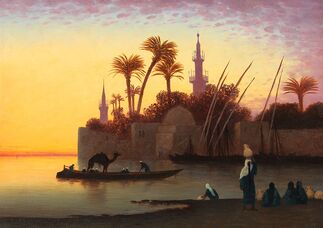
On the Nile (Art by Charles Theodore Frere)
The Nile is a Great Sacred River, believed by the Ancient Egyptians be a gift of the gods which they equated with life itself.
Overview[]
The daily life of Ancient Egypt was regulated by the rising and falling of the Nile. The river determined the Egyptian calendar and its three seasons: the season of flooding, the season of sowing and the season of harvesting.
The season of flooding started when the brightest star Sirius appeared in the night sky and marked the Egyptian New Year. When the Nile rose, it brought prosperity and fertility to the life surrounding it, but if the water level didn’t rise enough there would be famine or if the water level rose too much, people would lose their clay houses due to the flood. It was therefore important that the gods controlled the river. The two major gods involved in bringing stability to the Nile were Khnum and Hapi.
Gods of the Nile[]
Khnum[]
Khnum, the ram-headed god of the Nile, was considered to be the lord of the water and the one who brought life and fertility to the river banks where plants and animals thrived. Since the water would bring forth clay after flooding, Khnum was also thought to be creator of humans, who he is said to have molded out of the Element of clay. Khnum was worshiped on Elephantine Island, and his temple can be admired in Esna, located 60 km south of Luxor.
Hapi[]
Hapi is known as the god who controls the flooding of the Nile. Hapi is usually depicted as an androgynous figure in which the female and male sexes are combined. They have a masculine face and a feminine torso. This is to show Hapi as being both the father and the mother of the Nile and thus being able to bring fertility. The word hapi actually meant ‘happy’ in the ancient Egyptian language, due to the fertility and prosperity Hapi brought to the river banks. In multiple scenes in different temples, such as Karnak and Luxor Temples, Hapi can be seen performing a ceremony where they bundle lotus and papyrus together. This signified the union of Upper and Lower Egypt in prosperity, with the lotus representing the former and the papyrus representing the latter.
Anuket[]
Anuket, also known as Anaka, Anqet or Anukis, was considered the Egyptian goddess of the cataracts of the Nile and of lust. She was usually seen as the child of the gods Khnum and Satis, though some believed her to also be the consort of Khnum. She also formed a triad with these two other gods, which was known as the Elephantine Triad.
Sobek[]
Several Nile animals had a significant role in ancient mythology; particularly, Crocodiles and hippos were feared and therefore the Egyptians worshiped them so they would be protected from animal attacks and evil in general. The crocodile-god known as Sobek was worshiped in Fayoum and most importantly, in Kom Ombo where Sobek’s temple nowadays is visited by many travelers. Certain fish and birds of the Nile were seen as a sign of abundance, sustenance and rebirth in the afterlife.
Scattering of Osiris[]
According to the myth of Osiris, when he was killed by his brother Set due to jealousy, his body was chopped to forty pieces and thrown into the Nile. The current of the Nile carried him to the Mediterranean sea, where his wife Isis achieved finding and gathering his body parts. As the goddess of magic, Isis managed to revive Osiris and get pregnant. She gave birth to the god Horus and raised him in a papyrus field in the Delta, away from his spiteful uncle Set. Later in life, Horus avenged his father Osiris by killing his uncle. Due to Osiris’ death and resurrection, he became associated with the flooding and receding of the Nile. Scenes of this myth can be seen in the Temple of Horus in Edfu.